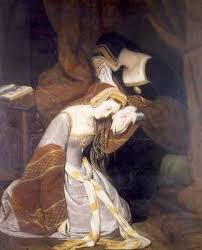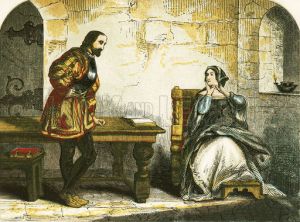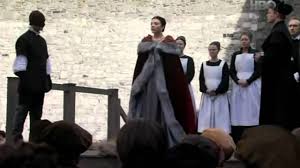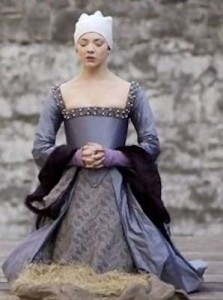 Based on material from The Creation of Anne Boleyn, by Susan Bordo
Based on material from The Creation of Anne Boleyn, by Susan Bordo
Expecting to die on the 18th, Anne took the sacrament at 2 a.m. By now all who were in contact with her must have been convinced of her innocence. Even her old enemy Chapuys was impressed by the fact that Anne, before and after receiving the Sacrament, affirmed to those who had charge of her “on damnation of her soul, that she had never offended with her body against the King.” In the 16th century, to speak anything other than the truth at such a time would be to invite the utter condemnation of God. Anne had nothing to gain and her salvation to lose by lying.
As Anne prepared for her death, Henry was spending much of his time at Chelsea, visiting Jane Seymour and making plans for their wedding. Chapuys describes the king as showing “extravagant joy” at Anne’s arrest. Convinced (or making a great show for posterity) that Anne was an “accursed whore” who had slept with hundreds of men, he was “very impatient” and wishing to have the thing done with “already.”
 Anne too wished to have the thing done. Yet, cruelly, the execution was delayed twice, once in order to clear the Tower of possible sympathetic observers, the second time because the executioner had been delayed. The first delay dismayed Anne, who thought that at the newly appointed hour she would already “be dead and past my pain.” Kingston, who seems to have been an absurdly literal man, took her to be referring to the physical pain of the execution itself, and reassured her that “there would be no pain, it was so subtle.” Anne replied with her most famous line: “I have heard say the executioner is very good, and I have a little neck.” And then, according to Kingston, “she put her hand around [her neck], laughing heartily.” Kingston flat-footedly interpreted this to mean that Anne had “much joy and pleasure in death.” He apparently did not “get” Anne’s irony. At the news of the second delay, she was distraught. But “It was not that she desired death,” as she told Kingston (or perhaps one of the ladies, who then told him) “but she had thought herself prepared to die, and feared that the delay would weaken her resolve. “ So much for Kingston’s theory that Anne felt “joy and pleasure” at the prospect of death.
Anne too wished to have the thing done. Yet, cruelly, the execution was delayed twice, once in order to clear the Tower of possible sympathetic observers, the second time because the executioner had been delayed. The first delay dismayed Anne, who thought that at the newly appointed hour she would already “be dead and past my pain.” Kingston, who seems to have been an absurdly literal man, took her to be referring to the physical pain of the execution itself, and reassured her that “there would be no pain, it was so subtle.” Anne replied with her most famous line: “I have heard say the executioner is very good, and I have a little neck.” And then, according to Kingston, “she put her hand around [her neck], laughing heartily.” Kingston flat-footedly interpreted this to mean that Anne had “much joy and pleasure in death.” He apparently did not “get” Anne’s irony. At the news of the second delay, she was distraught. But “It was not that she desired death,” as she told Kingston (or perhaps one of the ladies, who then told him) “but she had thought herself prepared to die, and feared that the delay would weaken her resolve. “ So much for Kingston’s theory that Anne felt “joy and pleasure” at the prospect of death.
 What she may have felt was something closer to what James Hillman describes as the state of mind that often precedes an attempt at suicide: a desperate desire to shed an old self whose suffering had become unbearable, and thus be “reborn” in the act of dying. This imagined rebirth, for Hillman, has nothing to do with belief in reincarnation, or even in heaven, but the perception, ironically, that the soul cannot survive under existing conditions. What Anne had been through was certainly enough to shatter any hold her previous life may have exerted on her. She had been discarded by the man who had pursued her for six years, fathered her daughter, and seemingly adored her for much of their time together. The person she was closest to in the world—her brother George—had been executed on the most hideous and shameful of charges. The rest of her family, as far as we can tell, had either abandoned her or—as Anne believed of her mother–was awash with despair and grief over what was happening. Still recovering from a miscarriage, her body and mind undoubtedly assaulted by hormonal changes and unstable moods, she had been sent to prison on absurd, concocted charges, and “cared for” there by women who were hostile spies. She knew she would never see her daughter Elizabeth again, and—unlike the fictional Anne of Anne of the Thousand Days, who predicts that “Elizabeth will be queen!”—had no hope, after Cranmer’s visit, that her child would ever be anything more than she had seen Mary reduced to: a bastardized ex-princess forced to bow down to any children the new wife might produce for Henry. She had been given reason to hope that she would be allowed to live, only to have those hopes crushed at her sentencing. In a sense, she had already been through dozens of dyings. Nothing was left but the withered skin of her old life, which she was ready to shed.
What she may have felt was something closer to what James Hillman describes as the state of mind that often precedes an attempt at suicide: a desperate desire to shed an old self whose suffering had become unbearable, and thus be “reborn” in the act of dying. This imagined rebirth, for Hillman, has nothing to do with belief in reincarnation, or even in heaven, but the perception, ironically, that the soul cannot survive under existing conditions. What Anne had been through was certainly enough to shatter any hold her previous life may have exerted on her. She had been discarded by the man who had pursued her for six years, fathered her daughter, and seemingly adored her for much of their time together. The person she was closest to in the world—her brother George—had been executed on the most hideous and shameful of charges. The rest of her family, as far as we can tell, had either abandoned her or—as Anne believed of her mother–was awash with despair and grief over what was happening. Still recovering from a miscarriage, her body and mind undoubtedly assaulted by hormonal changes and unstable moods, she had been sent to prison on absurd, concocted charges, and “cared for” there by women who were hostile spies. She knew she would never see her daughter Elizabeth again, and—unlike the fictional Anne of Anne of the Thousand Days, who predicts that “Elizabeth will be queen!”—had no hope, after Cranmer’s visit, that her child would ever be anything more than she had seen Mary reduced to: a bastardized ex-princess forced to bow down to any children the new wife might produce for Henry. She had been given reason to hope that she would be allowed to live, only to have those hopes crushed at her sentencing. In a sense, she had already been through dozens of dyings. Nothing was left but the withered skin of her old life, which she was ready to shed.
 As she mounted the scaffold, wearing a role of dark damask (black in some reports, grey in others) trimmed with white fur, with a red kirtle (petticoat) underneath—red being the liturgical color of Catholic martyrdom—political and national affiliations continued, as they had through her reign and would for centuries to come–to shape the descriptions of her appearance and behavior. To an author of the Spanish Chronicle, she exhibited “a devilish spirit.” A Portuguese witness who had snuck in despite the ban on “strangers”, wrote that “never had she looked so beautiful.” An imperialist observer described her as “feeble and stupefied” (which would be understandable, and not incompatible with her looking beautiful as well.) Wriothesley says she showed “a goodly smiling countenance.” French de Carles commented on the beauty of her complexion, pure and clear as though cleansed by all the suffering. For all, the spectacle of a queen, wearing the white ermine of her role, mounting the stairs to the scaffold, was unnerving.
As she mounted the scaffold, wearing a role of dark damask (black in some reports, grey in others) trimmed with white fur, with a red kirtle (petticoat) underneath—red being the liturgical color of Catholic martyrdom—political and national affiliations continued, as they had through her reign and would for centuries to come–to shape the descriptions of her appearance and behavior. To an author of the Spanish Chronicle, she exhibited “a devilish spirit.” A Portuguese witness who had snuck in despite the ban on “strangers”, wrote that “never had she looked so beautiful.” An imperialist observer described her as “feeble and stupefied” (which would be understandable, and not incompatible with her looking beautiful as well.) Wriothesley says she showed “a goodly smiling countenance.” French de Carles commented on the beauty of her complexion, pure and clear as though cleansed by all the suffering. For all, the spectacle of a queen, wearing the white ermine of her role, mounting the stairs to the scaffold, was unnerving.
 Unlike her trial speech and her “last letter,” Anne’s remarks on the scaffold made the more conventional bows to the goodness and mercy of the King—in this highly public context, it was virtually required, if only to prevent any retribution against surviving relatives—and asked the people to pray for her. She did not admit to guilt for the offenses with which she was charged or accuse the judges of malice, but did make reference to the “cruel law of the land by which I die.” By now, the four young ladies who had accompanied her to the scaffold (clearly not the hostile spies that had lived with her in the Tower, but others, more intimate with her, who she had been allowed to have with her in these last moments) were weeping. Anne, having helped them take off her robe—an act that in itself must have demanded great composure and courage—“appeared dazed” as he kneeled down, modestly covering her feet with her dress, and asked the executioner to remove her coif, lest it interfere with his stroke. The executioner realized that she was afraid of the pain of an impeded blow; she kept looking around her, her hand on her coif, anticipating the moment. Clearly “distressed” at the task he was to perform, he told her that he would wait until she gave the signal. “With a fervent spirit” she began to pray, and the Portuguese contingent, unable to bear it, huddled together and knelt down against the scaffold, wailing loudly.
Unlike her trial speech and her “last letter,” Anne’s remarks on the scaffold made the more conventional bows to the goodness and mercy of the King—in this highly public context, it was virtually required, if only to prevent any retribution against surviving relatives—and asked the people to pray for her. She did not admit to guilt for the offenses with which she was charged or accuse the judges of malice, but did make reference to the “cruel law of the land by which I die.” By now, the four young ladies who had accompanied her to the scaffold (clearly not the hostile spies that had lived with her in the Tower, but others, more intimate with her, who she had been allowed to have with her in these last moments) were weeping. Anne, having helped them take off her robe—an act that in itself must have demanded great composure and courage—“appeared dazed” as he kneeled down, modestly covering her feet with her dress, and asked the executioner to remove her coif, lest it interfere with his stroke. The executioner realized that she was afraid of the pain of an impeded blow; she kept looking around her, her hand on her coif, anticipating the moment. Clearly “distressed” at the task he was to perform, he told her that he would wait until she gave the signal. “With a fervent spirit” she began to pray, and the Portuguese contingent, unable to bear it, huddled together and knelt down against the scaffold, wailing loudly.
 Anne gave the signal. But either the executioner or someone else in charge had devised a scheme to distract Anne at the last moment, so the fatal blow would come when she wasn’t expecting it; he turned toward the scaffold steps and called for the sword, and when Anne blindly turned her head in that direction, he brought the sword down from the other side and swiftly “divided her neck at a blow.” As these things went—others had died only after multiple clumsy hackings—it was an easy death: if the naturalist Lewis Thomas has it right, it was far easier than her weeks of suffering in the Tower: “Pain, “ he writes, is useful for avoidance, for getting away when there’s time to get away, but when it is end game, and no way back, pain is likely to be turned off, and the mechanisms for this are wonderfully precise and quick. If I had to design an ecosystem in which creatures had to live off each other and in which dying was an indispensable part of living, I could not think of a better way to manage.” He quotes Montaigne, who nearly died in a riding accident and later described the “letting go” that he experienced at what could have easily been the very end:
Anne gave the signal. But either the executioner or someone else in charge had devised a scheme to distract Anne at the last moment, so the fatal blow would come when she wasn’t expecting it; he turned toward the scaffold steps and called for the sword, and when Anne blindly turned her head in that direction, he brought the sword down from the other side and swiftly “divided her neck at a blow.” As these things went—others had died only after multiple clumsy hackings—it was an easy death: if the naturalist Lewis Thomas has it right, it was far easier than her weeks of suffering in the Tower: “Pain, “ he writes, is useful for avoidance, for getting away when there’s time to get away, but when it is end game, and no way back, pain is likely to be turned off, and the mechanisms for this are wonderfully precise and quick. If I had to design an ecosystem in which creatures had to live off each other and in which dying was an indispensable part of living, I could not think of a better way to manage.” He quotes Montaigne, who nearly died in a riding accident and later described the “letting go” that he experienced at what could have easily been the very end:
“It was an idea that was only floating on the surface of my soul, as delicate and feeble as all the rest, but in truth not only free from distress but mingled with that sweet feeling that people have who have let themselves slide into sleep. I believe this is the same state in which people find themselves whom we see fainting in the agony of death, and maintain that we pity them without cause…If you know not how to die, never trouble yourself; Nature will in a moment fully and sufficiently instruct you; she will exactly do that business for you; take you no care with it”
Anne’s preparations for dying, facing the inevitability of her execution, may have been filled with internal good-byes to those she loved, relief at the shedding of a suffering self, or imaginings of meeting her God. I like to think of her final hours as immensely rich, in a way that I cannot comprehend but that were sustaining to her, even beyond her more conventional—but extremely deep, for Anne—religious faith. And then, at the end, I hope that nature or God (it makes no difference), gave her no more to figure out, no more to regret, no more to say good-bye to, no more work to do, and took care of her dying.

 Purchase The Creation of Anne Boleyn: A New Look at England's Most Notorious Queen (US)
Purchase The Creation of Anne Boleyn: A New Look at England's Most Notorious Queen (US)
I admire this woman for her resourcefulness, her courage, her driving will, her ambition, her loyalty, her intelligence, her piety… Above all, she was a complex, two-dimensional and multifaceted human being, a concept which so many people still seem to struggle with. I have not found anyone in history who fascinates me as much as Anne Boleyn. I think she was an absolutely incredible woman who achieved things others could only dream about. She was cut down cruelly and unjustly in the prime of her youth, who knows how much longer she could have lived and how much more she could have achieved. I think her continuing legacy speaks volumes about her as a person, and I hope she has achieved the peace in death she was denied so cruelly in life, whether by the suspicion of her husband, the pressures of her position, or the slanders of court gossips and the nation at large. She has been so maligned and misrepresented even nearly five hundred years on. I admire Anne Boleyn and I congratulate her for everything she achieved in her inspiring life. RIP the Queen!
Well said, Conor!
Pingback: Anne’s Final Hours | The son of Louis Chapuys and Guigonne Dupuys, was a Savoyard diplomat who served Charles V as Imperial ambassador to England